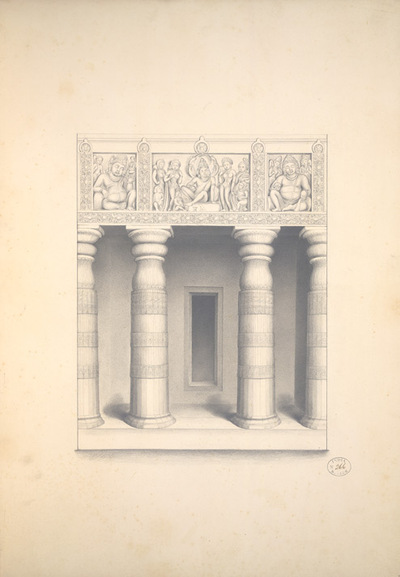Javascript must be enabled to continue!
Cave 2, Entrance to Cell at Right Hand End of Porch
View through Europeana Collections
Pencil drawing of the entrance to the cell at the
right hand end of the porch of Cave 2 at Ajanta, from an Album of
26 ground plans of the Ajanta caves and 16 folios of drawings of
sculpture and architectural details in the Ajanta caves, by Capt.
R. Gill, dated c.1850.The magnificent cave temples of Ajanta are
situated in a horse-shoe valley of the Waghora river in West India
and consist of prayer halls (chaityas) and monasteries (viharas),
built for the Buddhist community who lived there. The first group
was excavated between the second - first centuries BC; then, after
a period of more than six centuries, the excavations restarted
around the fifth century AD, in the Vakataka period. Cave 2 is a
monastery from the late fifth century with profuse sculptural
ornamentation. This drawing depicts the elaborate facade of the
cell at the right hand of the porch. It is supported by two pillars
with delicately carved shaft and fluted capitals. The panels carved
above depict a seated Naga (serpent) king with yaksha (nature
spirits) attendants. The cave is remarkable for its painted
ceilings and for the magnificent wall painting that adorn its
walls.
The British Library
Title: Cave 2, Entrance to Cell at Right Hand End of Porch
Description:
Pencil drawing of the entrance to the cell at the
right hand end of the porch of Cave 2 at Ajanta, from an Album of
26 ground plans of the Ajanta caves and 16 folios of drawings of
sculpture and architectural details in the Ajanta caves, by Capt.
R.
Gill, dated c.
1850.
The magnificent cave temples of Ajanta are
situated in a horse-shoe valley of the Waghora river in West India
and consist of prayer halls (chaityas) and monasteries (viharas),
built for the Buddhist community who lived there.
The first group
was excavated between the second - first centuries BC; then, after
a period of more than six centuries, the excavations restarted
around the fifth century AD, in the Vakataka period.
Cave 2 is a
monastery from the late fifth century with profuse sculptural
ornamentation.
This drawing depicts the elaborate facade of the
cell at the right hand of the porch.
It is supported by two pillars
with delicately carved shaft and fluted capitals.
The panels carved
above depict a seated Naga (serpent) king with yaksha (nature
spirits) attendants.
The cave is remarkable for its painted
ceilings and for the magnificent wall painting that adorn its
walls.
Related Results
Entrance to the cave temple of Karle. Copy of an original
sketch of 1805
Entrance to the cave temple of Karle. Copy of an original
sketch of 1805
Water-colour by James Broff Byers of the entrance
to the cave temple of Karle, dated 1815. Inscribed on reverse:
'View of the Entrance, or External Appearance of the magnificent
Ca...
General view of cave temples in the Barabar Hills, Gaya
(Bihar). January 1814
General view of cave temples in the Barabar Hills, Gaya
(Bihar). January 1814
Water-colour of the cave temples in the Barabar
Hills, at Gaya in Bihar, dated January 1814. Inscribed on front in
ink: 'View of the Rock of the Caverns at - mile from Ghya.' '
Jan...
Cave 1, Details of Pillars f.30
Cave 1, Details of Pillars f.30
Pencil drawing of pillars from Cave 1 at Ajanta,
from an Album of 26 ground plans of the Ajanta caves and 16 folios
of drawings of sculpture and architectural details in the Ajanta...
Cave 1, Details of Pillars f.33
Cave 1, Details of Pillars f.33
Pencil drawing of pillars and pilasters from Cave
1 at Ajanta, from an Album of 26 ground plans of the Ajanta caves
and 16 folios of drawings of sculpture and architectural details...
Cave 1, Details of Pillars f.34
Cave 1, Details of Pillars f.34
Pencil drawing of pillars from Cave 1 at Ajanta,
from an Album of 26 ground plans of the Ajanta caves and 16 folios
of drawings of sculpture and architectural details in the Ajanta...
A sack-back gown, petticoat and stomacher made in the late 1760s of 1730s silk and trimmed with knotted silk fringe. It may have been remade from a mantua, as the petticoat is pieced with plain silk at the back. Has also been worn for 19th century fancy d
A sack-back gown, petticoat and stomacher made in the late 1760s of 1730s silk and trimmed with knotted silk fringe. It may have been remade from a mantua, as the petticoat is pieced with plain silk at the back. Has also been worn for 19th century fancy d
A sack-back gown, petticoat and stomacher made in the late 1760s of 1730s silk and trimmed with knotted silk fringe. It may have been remade from a mantua, as the petticoat is piec...
f.25 Dumar Lena Cave with sculpture of Ravana rocking Mount
Kailasa, Cave 29, Ellora. 'Entrance to Dhurma Lena. Septr.
25.'
f.25 Dumar Lena Cave with sculpture of Ravana rocking Mount
Kailasa, Cave 29, Ellora. 'Entrance to Dhurma Lena. Septr.
25.'
Wash and watercolour drawing of the sculpture of
Ravana shaking Mount Kailasa from Dhumar Lena, Cave 29 at Ellora,
from an Album of 83 drawings; 80 of landscapes and antiquities in...
f.28 Entrance to Dumar Lena Cave with sculpture of Siva's
Dance in the Elephant Skin, Cave 29, Ellora. 'Dhurma Lena. 26
Sept.'
f.28 Entrance to Dumar Lena Cave with sculpture of Siva's
Dance in the Elephant Skin, Cave 29, Ellora. 'Dhurma Lena. 26
Sept.'
Wash and watercolour drawing of the Dhumar Lena,
Cave 29 at Ellora, from an Album of 83 drawings; 80 of landscapes
and antiquities in the northem Deccan, 2 portraits and 1 flower
s...




